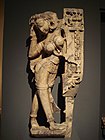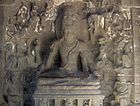The first sculptures in the Indian subcontinent date back to the Indus Valley civilization, where stone and bronze carvings have been discovered. This is one of the earliest instances of sculpture in the world. Later, as Hinduism, Buddhism and Jainism developed further, India produced some of the most intricate bronzes in the world, as well as unrivaled temple carvings. Some huge shrines, such as the one at Ellora were not actually constructed using blocks, but instead carved out of rock, making them perhaps the largest and most intricate sculptures in the world.
During the 2nd to 1st century BCE in far northern India, in what is now southern Afghanistan and northern Pakistan, sculptures became more explicit, representing episodes of the Buddha's life and teachings. Although India had a long sculptural tradition and a mastery of rich iconography, the Buddha was never represented in human form before this time, but only through some of his symbols. This may be because Gandharan Buddhist sculpture in modern Afghanistan displays Greek and Persian artistic influence. Artistically, the Gandharan school of sculpture is said to have contributed wavy hair, drapery covering both shoulders, shoes and sandals, acanthus leaf decorations, etc.
The pink sandstone sculptures of Mathura evolved during the Gupta period (4th to 6th century) to reach a very high fineness of execution and delicacy in the modeling. Newer sculptures in Afghanistan, in stucco, schist or clay, display very strong blending of Indian post-Gupta mannerism and Classical influence, Hellenistic or possibly even Greco-Roman. Meanwhile, elsewhere in India, less anatomically accurate styles of human representation evolved, leading to the classical art that the world is now familiar with, and contributing to Buddhist and Hindu sculpture throughout Asia.
[edit] Gallery
-
Marble stone work, Jaisalmer Jain Temple,Rajasthan
-
Seated Ganesha, sandstone sculpture from Rajasthan, India, 9th century, Honolulu Academy of Arts
-
yellow sandstone Sculpture of a Standing deity,11th century CE, Rajasthan
[edit] References
| Wikimedia Commons has media related to: Sculptures in India |
- Havell, E. B. (1906). Monograph on stone-carving in Bengal. The Bengal Secreteriat Book Depot. http://www.archive.org/stream/cu31924059519748#page/n3/mode/2up.
- Havell, E. B. (1908). Indian sculpture and painting. John Murray, London. http://www.archive.org/stream/cu31924016181798#page/n9/mode/2up.
- Coomaraswamy, Ananda K. (1914). Viśvakarmā ; examples of Indian architecture, sculpture, painting, handicraft. London. http://www.archive.org/stream/cu31924022942993#page/n3/mode/2up.
Sanskar India Agency.
40/13.Shakti Nagar.
Delhi-110007
India















No comments:
Post a Comment